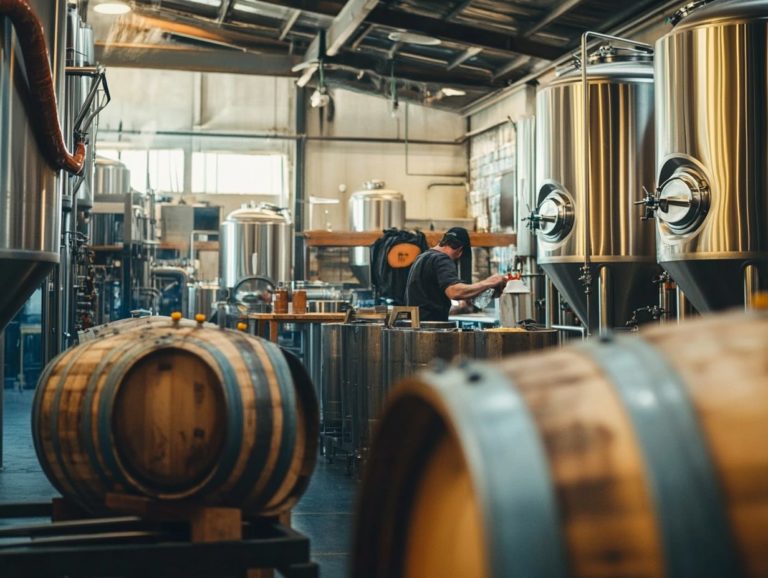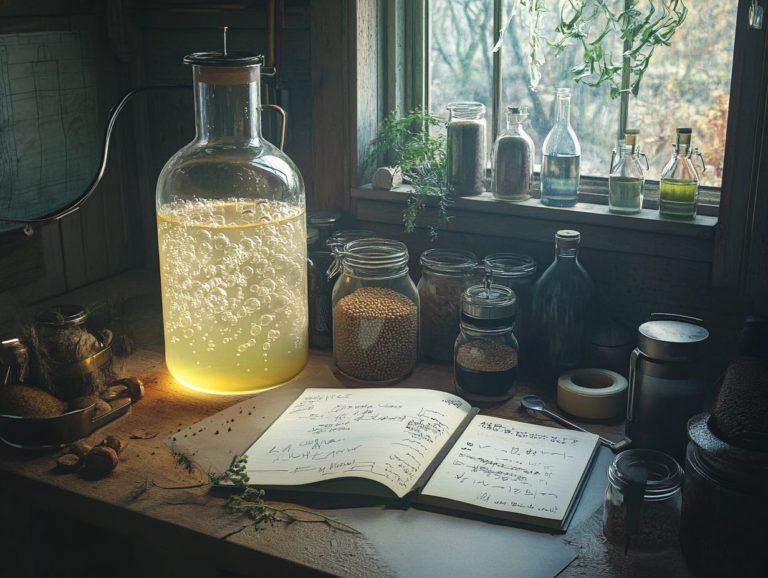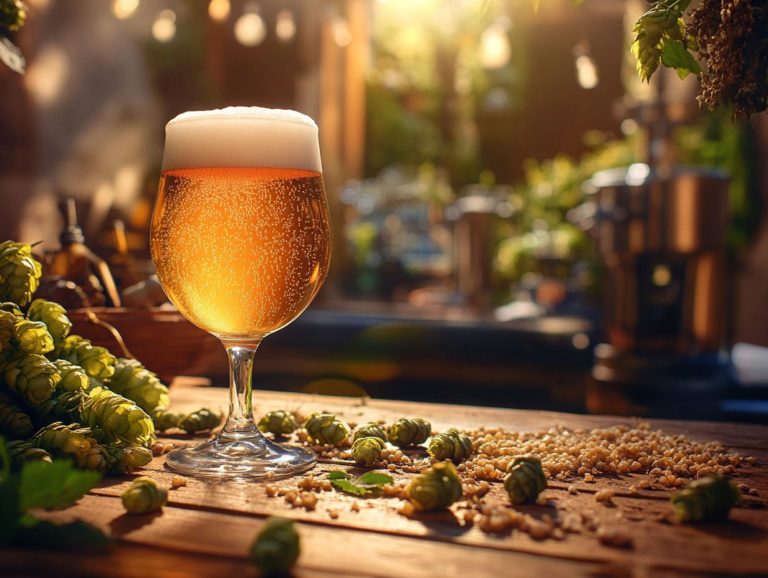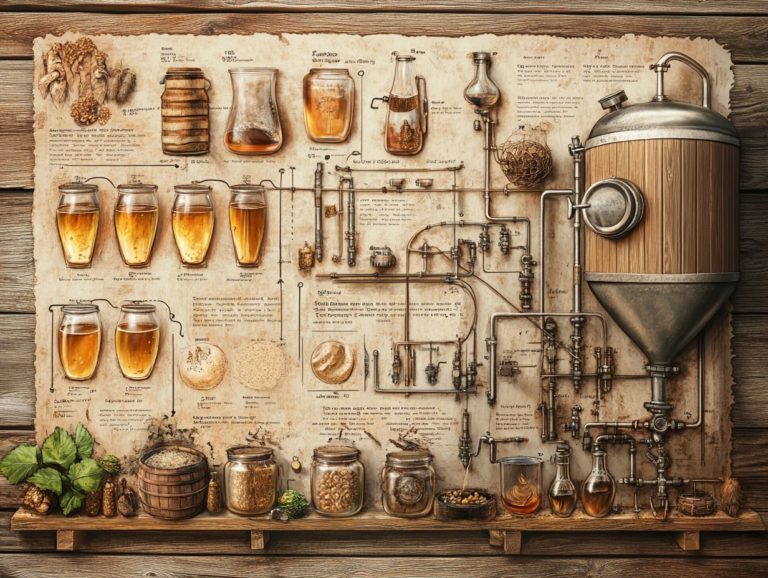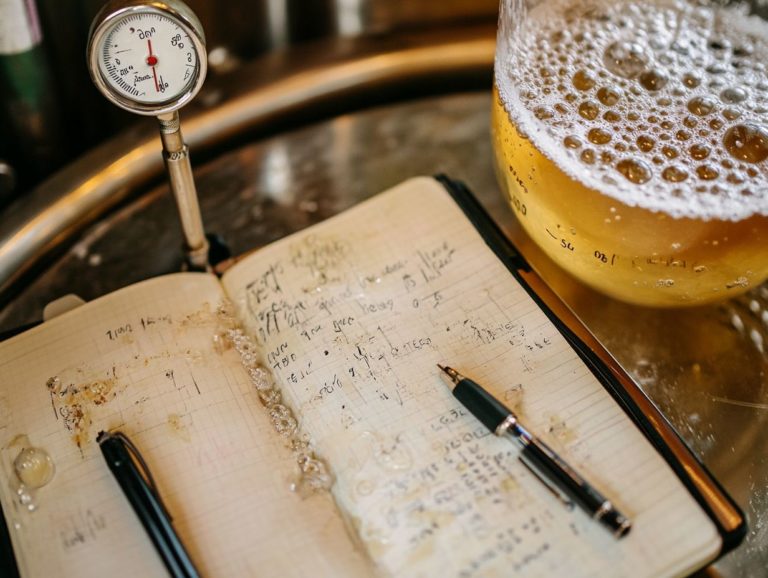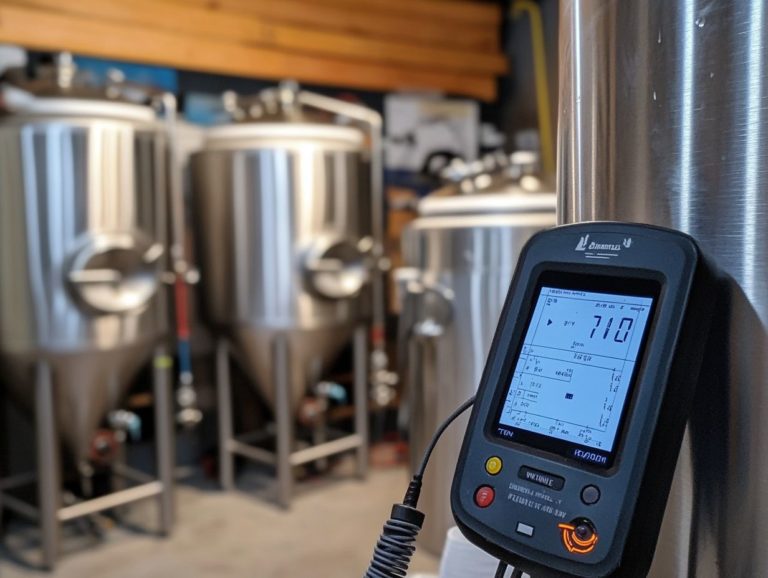The Role of Fermentation in Beer Styles
Contents
- Understanding Beer Fermentation
- Key Takeaways:
- The Basics of Fermentation
- The History of Fermentation in Beer
- The Different Types of Fermentation in Beer
- Top-Fermenting
- Bottom-Fermenting
- Spontaneous Fermentation
- The Role of Fermentation in Different Beer Styles
- The Importance of Fermentation Temperature in Beer Making
- Frequently Asked Questions
- The Role of Fermentation in Beer Brewing
Understanding Beer Fermentation
Beer fermentation is an intriguing process that elevates simple ingredients into the intricate flavors and aromas found in beer. In this exploration, you ll delve into the fundamentals of beer fermentation, tracing its rich history within beer production and how it has transformed over the centuries.
You will uncover the various types of fermentation employed in brewing, from top and bottom fermentation to spontaneous methods. These techniques contribute to the diverse array of beer styles.
You will learn how fermentation temperature shapes the final product, including the impact of temperature control on fermentation activity. Now, raise your glass and enjoy the exciting science behind your favorite brews!
Key Takeaways:
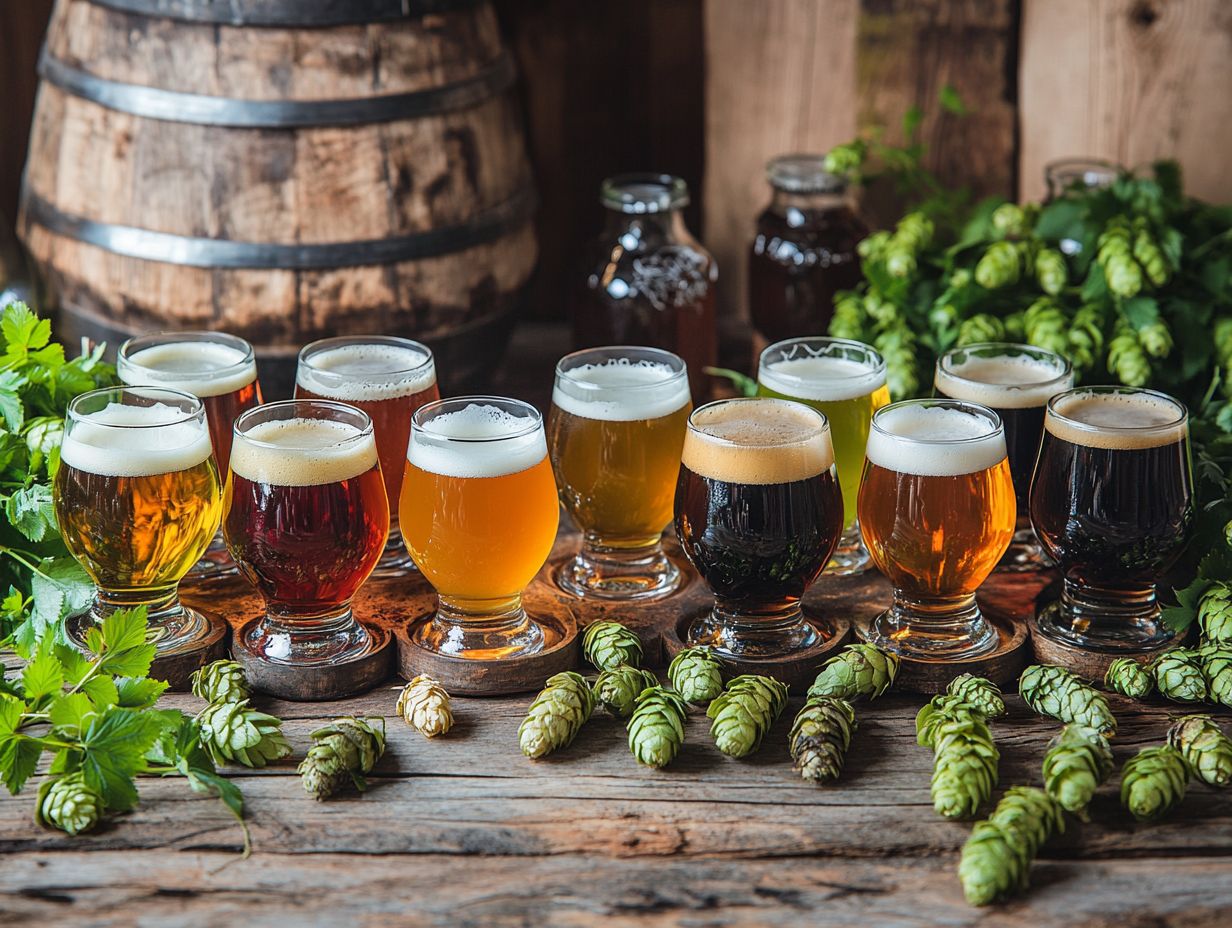
- Fermentation is a key process in beer making that transforms sugars into alcohol and carbon dioxide (CO2), driven by yeast metabolism.
- Fermentation has a rich history in the development of different beer styles from ancient civilizations to modern craft breweries, with notable contributions from Germany and Belgium.
- The type of fermentation, such as top-fermenting or spontaneous, greatly impacts the flavor and profile of the final product, emphasizing the importance of yeast selection.
The Basics of Fermentation
Fermentation is a fascinating biological process that transforms sugars into alcohol and carbon dioxide (CO2), serving as a pivotal stage in the art of brewing beer. This intricate brewing process relies on specific yeast strains such as ale yeasts, lager fermentation, and Kveik yeast varieties that are carefully chosen to shape the flavor compounds and overall character of the beer you re creating.
Understanding fermentation is crucial for anyone who wants to brew great beer. It gives you the power to control fermentation conditions, optimize yeast growth, and ultimately craft a superior product.
During the active phase of fermentation, yeast metabolism takes center stage. Yeast converts fermentation sugars, enriching the beer with its distinctive flavor profiles that are influenced by various stages of fermentation.
What Is Fermentation?
Fermentation is a fascinating metabolic process where microorganisms, particularly yeast, transform sugars into ethanol and carbon dioxide (CO2). This plays a crucial role in the art of beer production, heavily influenced by various fermentation phases.
During fermentation, sugars like glucose and fructose, derived from malted grains, are broken down by enzymes. These sugars serve as the primary energy source for the yeast. This yeast metabolism involves a series of intricate biochemical reactions that lead to the conversion of these simple sugars into alcohol and gas. The resulting fermentation byproducts, especially ethanol, are vital for the alcoholic content of your beverage, while CO2 adds that delightful carbonation, elevating your sensory experience of beer.
The careful management of fermentation conditions significantly influences flavor development and the overall profile of the brew. This process is essential for brewers dedicated to achieving quality and character in every sip of beer through meticulous fermentation control.
How Does Fermentation Work?
The fermentation process unfolds through multiple stages. You actively stimulate yeast growth to transform fermentation sugars into alcohol and other byproducts, ultimately defining the unique characteristics of your beer.
Initially, yeast cells awaken from dormancy and kickstart their metabolic activities by consuming the available sugars in the wort. This phase is crucial, as the yeast’s ability to thrive directly influences the flavor and aroma profile of your brew through optimal yeast propagation.
Your brewing equipment plays an essential role during fermentation. The fermentation vessels provide a controlled environment for yeast activity, ensuring proper oxygen levels through wort aeration while safeguarding against contamination.
Temperature control is vital in this process, as it regulates yeast activity. Warmer conditions can speed up fermentation but might also lead to off-flavors. Optimal temperature management, including monitoring diacetyl levels, is key for you to achieve a well-balanced beer that meets your desired specifications.
Ready to brew? Dive into fermentation and create your signature beer today!
The History of Fermentation in Beer
The history of fermentation in beer stretches back thousands of years. Traces of brewing practices have been discovered in ancient civilizations, particularly in Germany and Belgium, marking significant milestones in brewing history.
In these regions, fermentation techniques were meticulously refined over time. This refinement gave rise to distinct beer styles. Early brewers were true pioneers, experimenting with various fermentation conditions and yeast strains. Their efforts ultimately led to the development of favorable brewing methods that have profoundly influenced modern brewing techniques.
This rich historical evolution reveals how those initial brewing methods laid a strong foundation for today s complex and diverse flavor profiles. This emphasizes the critical importance of both yeast selection and meticulous fermentation control.
When Was Fermentation First Used in Beer Making?
Fermentation has a rich history that dates back to as early as 5,000 B.C. Ancient cultures like the Sumerians and Egyptians first discovered its application in beer making. Imagine the early brewers relying on naturally occurring yeast. They used grains such as barley and emmer wheat to craft their beverages.
The Sumerians, in particular, left behind clay tablets that detailed their brewing techniques. This reveals a sophisticated understanding of the process. Meanwhile, the Egyptians were experimenting with various herbs and spices, adding complexity to their flavors.
As trade routes expanded, the knowledge of brewing began to spread. It reached other ancient civilizations like the Babylonians and Greeks, who further refined these artisanal methods. By the time the Middle Ages rolled around, brewing had undergone significant evolution. Monasteries emerged as the pioneers in perfecting recipes and techniques.
This laid the groundwork for the diverse and sophisticated brewing practices that you appreciate today. Each brewing method carries its unique cultural flair and tradition.
How Has Fermentation Evolved in Beer Styles?
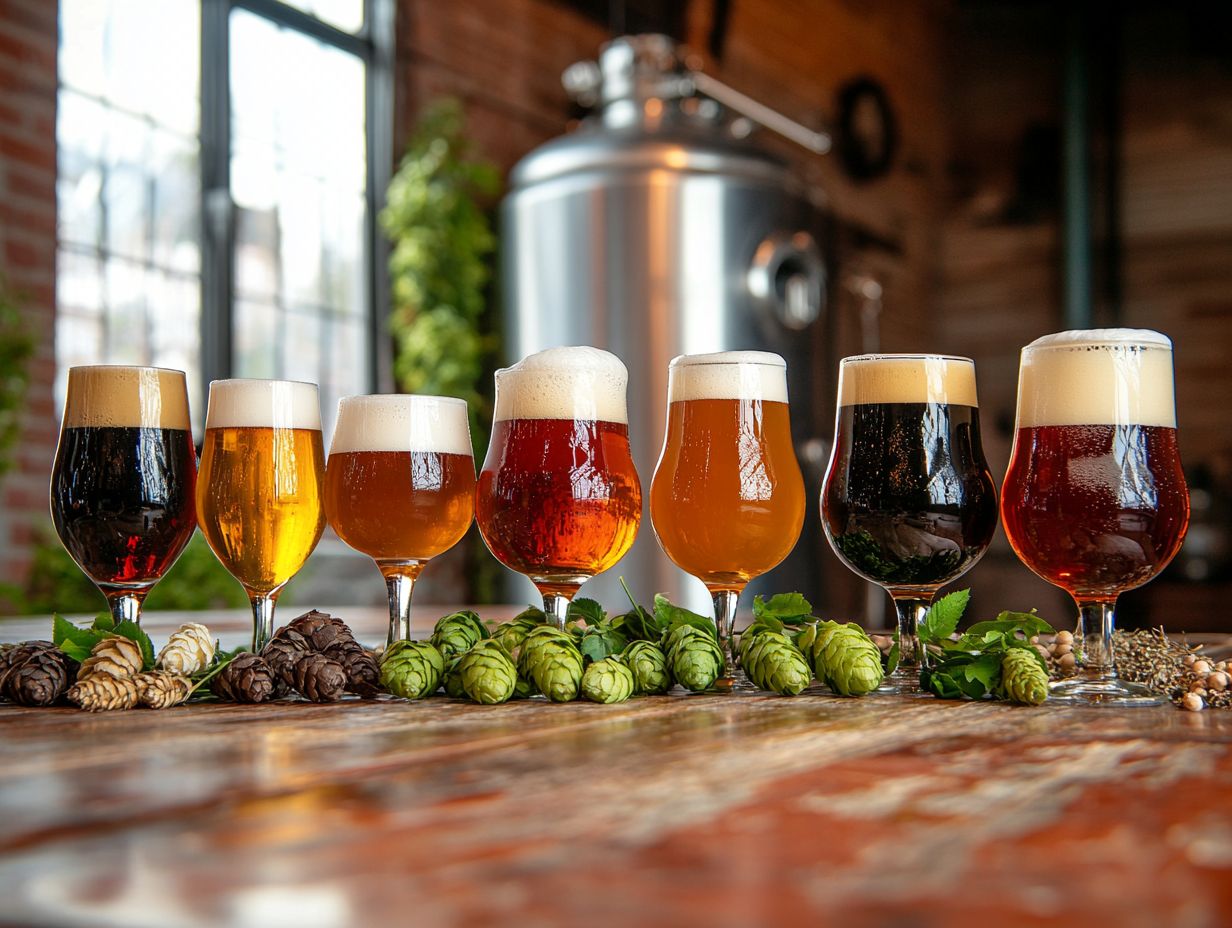
Over the centuries, fermentation techniques have undergone a remarkable evolution. This evolution has given rise to a stunning variety of beer styles such as ales and lagers. Each style boasts unique fermentation processes and distinct yeast strains, including the fascinating Kveik yeast.
Kveik showcases unique fermentation characteristics. This evolution has transformed the taste and aroma profiles of these cherished beverages. It has also underscored the pivotal role of yeast selection and brewing methods.
For example, Kveik yeast thrives at higher temperatures. It produces fruity esters that stand in stark contrast to the cleaner, crisper profiles achieved with traditional lager yeasts that prefer cooler conditions.
Thanks to advancements in fermentation technology, you can now control variables like temperature and oxygen levels with precision. This results in an impressive array of flavor compounds.
From the bold, citrusy hop notes found in IPAs to the rich, malty undertones that characterize stouts, the possibilities are thrilling and endless! Brewing consultant Kara Taylor from White Labs highlights these developments.
The brewing landscape continues to flourish. It seamlessly blends time-honored techniques with modern innovations to craft unique and flavorful beers that cater to every palate.
The Different Types of Fermentation in Beer
Understanding the various types of fermentation in beer is crucial for you as a brewer. This knowledge helps in crafting specific flavor profiles and aromas. The primary categories include top-fermenting, bottom-fermenting, and spontaneous fermentation methods. Each category has distinct fermentation patterns.
Top-fermenting yeasts, commonly used in ales, thrive at warmer temperatures. This results in a quicker fermentation process and bolder flavors, often seen during high krausen.
In contrast, bottom-fermenting yeasts used in lagers operate at cooler temperatures. They produce a cleaner, crisper taste.
Then there s spontaneous fermentation. This method embraces wild yeast to create unique and complex flavor characteristics that are highly prized in certain beer styles. It showcases the rich diversity of brewing techniques at your fingertips!
Discover your favorite beer style today!
Top-Fermenting
Top-fermenting, a technique primarily associated with ale production, involves yeast strains that rise to the surface during fermentation. This process not only creates a robust flavor profile but also accelerates fermentation, especially in the presence of yeast nutrients.
This method typically functions within a temperature range of 60 to 75 degrees Fahrenheit, which encourages the growth of specific yeast strains, such as Saccharomyces cerevisiae. These particular yeast strains are essential because they not only drive fermentation but also impart the distinct flavors and aromas that define various ale styles, influencing yeast flocculation (the process where yeast clumps together and settles).
The interaction between temperature and yeast selection is critical in shaping the beer’s final taste, resulting in an array of profiles that can range from fruity and spicy to rich and malty.
Top-fermenting ales often exhibit a complexity that is both intriguing and delightful for your palate, showcasing diverse fermentation characteristics.
Bottom-Fermenting
Bottom-fermenting is a fascinating method employed in lager production, where yeast strains settle at the bottom of fermentation vessels. This technique not only results in a cleaner taste but also leads to longer fermentation cycles, following specific brewing guidelines.
This unique fermentation process hinges on maintaining precise temperature ranges, typically between 45 F to 55 F (7 C to 13 C). By keeping things cool, you slow down the yeast’s activity, allowing for a gradual development of flavors while facilitating the effective flocculation of yeast cells.
As a result, the yeast clusters together, sinking to the bottom and leaving behind a striking clarity in the finished lager.
This clarity creates a striking difference compared to the cloudiness of ales, making lagers a true delight for the eyes and palate. The extended fermentation period allows your beer to develop a smooth, well-rounded flavor profile characterized by subtlety rather than the pronounced fruitiness frequently associated with top-fermented beverages.
Spontaneous Fermentation
Spontaneous fermentation is a captivating brewing technique that harnesses wild yeast strains from the environment to create beer with distinctive and complex flavor profiles. Unlike traditional fermentation methods, where a specific yeast strain is meticulously cultivated and added to the wort, this process invites the natural elements by exposing the wort to open air.
This openness allows a diverse array of wild yeasts and bacteria to take hold, resulting in a wonderfully unpredictable outcome.
This unpredictability can give rise to classic beer styles like Lambics, Flanders Red Ales, and Gueuze, all renowned for their delightful tartness and aromatic complexity. However, you must tread carefully, as wild yeast can occasionally introduce undesirable flavors if not managed correctly.
It s a delicate balancing act the intricate dance between risk and reward that true aficionados of the craft deeply appreciate.
The Role of Fermentation in Different Beer Styles
Fermentation is essential in shaping the unique characteristics and flavor profiles of various beer styles, whether it’s the hoppy bitterness of pale ales and IPAs or the rich, roasted notes found in stouts and porters.
Each style employs specific fermentation techniques and yeast strains that enhance the overall aroma, taste, and mouthfeel. For example, when it comes to sour beers, wild yeast and bacteria play a pivotal role, while Belgian ales are celebrated for the complex esters generated during fermentation.
This diversity in fermentation processes truly highlights its profound impact on the art of brewing.
Now that you understand the fascinating world of fermentation, try brewing your own beer and explore these unique flavors!
Pale Ales and IPAs
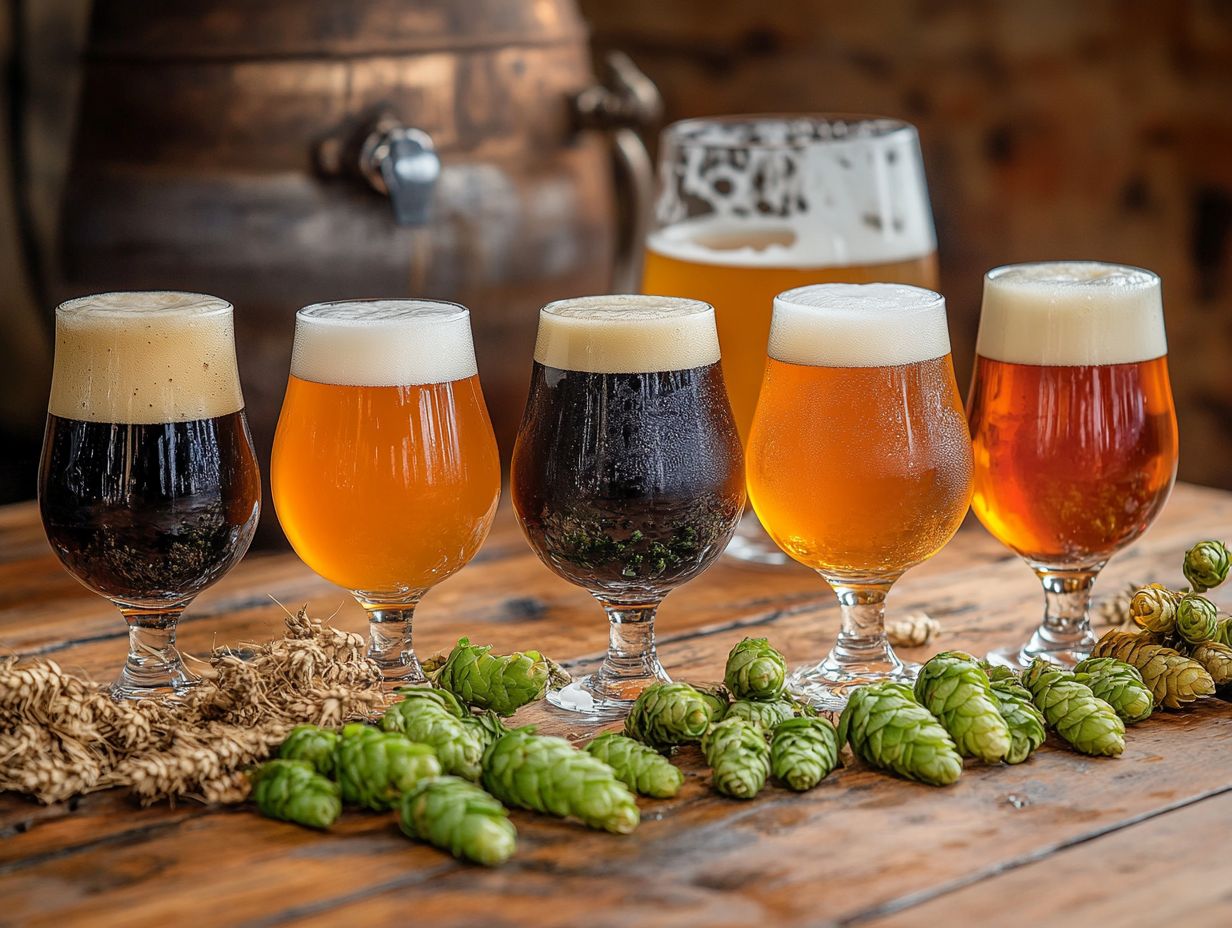
Pale ales and IPAs are celebrated for their vibrant hoppy flavors and enticing aromas, deeply shaped by the fermentation process and the choice of specific yeast strains.
These beer styles thrive on the delicate equilibrium between yeast activity and fermentation temperature, where even slight variations can unleash a remarkable array of taste experiences. For example, opting for a fruity or estery yeast strain can infuse your brew with layers of complexity and rich aromatics, bringing forth delightful citrus or tropical notes that beautifully accentuate the hoppy essence.
Consider the fermentation temperature it plays a pivotal role in the character of your beer. Warmer conditions often yield more pronounced esters and phenols, while cooler fermentations deliver a cleaner, crisper profile. By grasping and skillfully manipulating these elements, you can dramatically influence the final product, give the power toing you to create distinctive and unforgettable pale ales and IPAs that resonate with a wide range of palates.
Stouts and Porters
Stouts and porters are rich, dark beers that owe their distinct flavor profiles to specific fermentation processes and the careful selection of roasted malt.
Brewing these beloved styles is a meticulous craft that highlights the importance of yeast selection and fermentation timing. You ll often find brewers opting for particular yeast strains that not only ferment effectively under the given conditions but also impart unique esters and phenols to the beer’s character.
For example, choosing the right yeast can amplify chocolate or coffee notes that stem from the roasted malts. The timing of fermentation plays a crucial role in shaping the final aroma and flavor; conducting primary fermentation at slightly warmer temperatures can lead to a more intricate interplay of flavors, ultimately enhancing your drinking experience.
This fascinating relationship between yeast, time, and ingredients is what makes stouts and porters so captivating for craft beer enthusiasts like yourself.
Sours and Lambics
Sours and lambics are truly exceptional beer styles, harnessing the art of spontaneous fermentation and wild yeast to create complex acidity and flavor profiles that are highly sought after by discerning beer lovers.
These beverages embrace the unpredictability of nature, welcoming wild yeast strains like Brettanomyces and a variety of bacteria into the brewing process. The intricate interplay between these microorganisms results in an astonishing array of flavors, ranging from tart and fruity to earthy and funky, creating a tasting experience that more controlled brewing methods simply cannot replicate.
The regional terroir is essential here, as the ambient yeast and bacteria present in the brewery environment contribute significantly to the beer s final character. This approach nurtures not only a diverse sensory experience but also weaves a narrative of the surroundings from which the beer is born, ensuring that each batch is a unique reflection of its origins.
Belgian Ales
Belgian ales are celebrated for their intricate flavors, a phenomenon directly tied to the specific fermentation practices and carefully selected yeast strains employed during brewing.
The unique characteristics of these ales arise from the remarkable variety of yeast strains, each contributing distinct esters that enrich the beer’s flavor profile. These esters, created during fermentation, often evoke delightful fruity and floral notes, enhancing both the aroma and the overall tasting experience.
You ll find that fermentation temperature plays a vital role in this process; higher temperatures can amplify the production of these sought-after compounds, while cooler conditions might yield a more refined finish. It s this delicate interplay between yeast behavior and fermentation conditions that is key to crafting the delightful complexity for which Belgian ales are renowned, making each sip an exquisite journey through rich layers of flavor.
The Importance of Fermentation Temperature in Beer Making
Fermentation temperature plays a pivotal role in the brewing process, as it directly impacts yeast metabolism and the creation of flavor compounds. This ultimately defines the beer’s taste and aroma.
Each beer style demands distinct temperature ranges to achieve optimal fermentation. Higher temperatures can lead to heightened ester and phenol production, while lower temperatures typically result in a cleaner, crisper flavor profile.
By grasping the importance of temperature control, you can craft beers that align perfectly with your desired fermentation characteristics and flavor profiles.
What Is the Ideal Temperature for Fermentation?
The ideal temperature for fermentation is not a one-size-fits-all scenario; it varies based on the yeast strain and the type of beer you re brewing. Ale yeasts thrive in the cozy range of 65 F to 75 F.
Lager yeasts prefer the cooler embrace of temperatures around 45 F to 55 F.
These temperature ranges are crucial for fermentation. They significantly influence the production of esters and phenols, which are key players in shaping the aroma and taste profile of your final brew. When crafting a Belgian ale, you might choose to ferment at the higher end of that range to coax out those delightful fruity and spicy notes. In contrast, a lager, fermented in cooler conditions, will result in a cleaner, crisper flavor profile.
Styles like IPAs excel around 68 F to 72 F, enhancing those bold hop characteristics that enthusiasts love. Stouts can also be brewed effectively at similar temperatures to bring out rich, roasted flavors. By understanding these nuances, you can master the art of brewing beers with distinct and delightful profiles that truly stand out.
How Does Temperature Affect the Flavor of Beer?
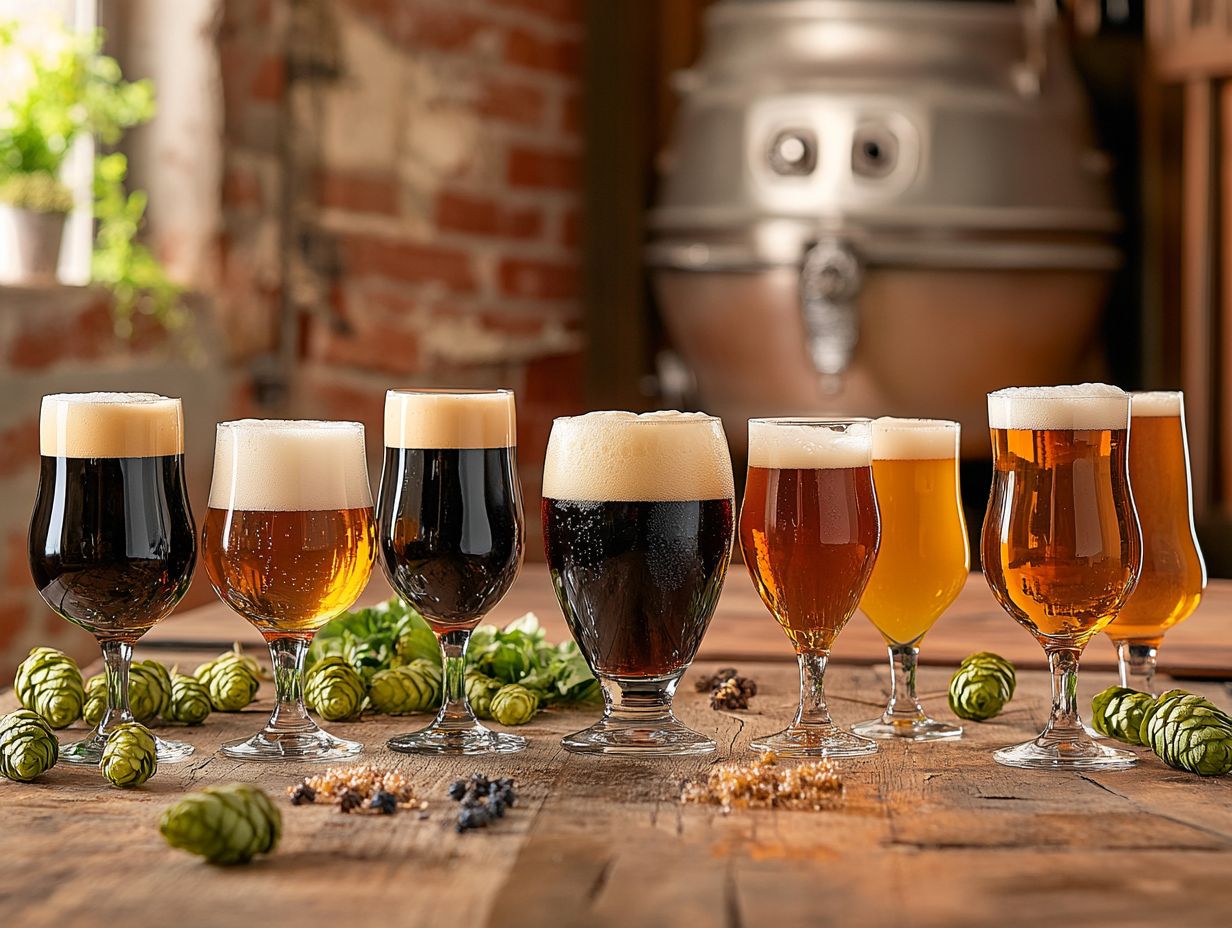
Temperature plays a crucial role in shaping the flavor of your beer. It directly influences yeast performance during fermentation and the production of essential flavor compounds.
In the world of craft brewing, even slight fluctuations can lead to remarkably different outcomes. When you opt for higher fermentation temperatures, you encourage the yeast to produce a greater amount of esters, imparting delightful fruity and floral notes to your brew. This effect is particularly noticeable in styles like Hefeweizen, where warmer temperatures amplify the banana and clove flavors that define this beer.
On the flip side, if you prefer a cooler fermentation temperature, especially for styles such as lagers, you achieve a clean and crisp profile with minimal ester production. This allows the malt and hop characteristics to take center stage.
Grasping how temperature control can influence these processes is essential for you as a brewer. This understanding is especially important if you’re aiming to attain specific flavor profiles that will impress your palate.
Frequently Asked Questions
What is the role of fermentation in different beer styles?
Fermentation is a crucial step in the brewing process that converts sugars into alcohol and carbon dioxide. This gives beer its signature flavor and carbonation. Different fermentation methods and yeast strains are used to create unique beer styles.
How does fermentation impact the flavor of beer?
Fermentation produces a variety of flavor compounds that give beer its distinct taste. These compounds can range from fruity and spicy to earthy and funky, depending on the type of yeast and fermentation process used.
Why is temperature important in fermentation for different beer styles?
The temperature at which fermentation takes place greatly affects the outcome of the beer. Lower temperatures produce clean and crisp flavors, while higher temperatures can create more complex and estery flavors.
What role does yeast play in fermentation for different beer styles?
Yeast is responsible for converting sugars into alcohol and carbon dioxide during fermentation. Different yeast strains can produce varying flavors and aromas, making them an essential factor in creating different beer styles.
The Role of Fermentation in Beer Brewing
Let’s explore how fermentation influences beer. It’s a fascinating process that shapes both flavor and appearance.
How Does Fermentation Impact the Appearance of Beer?
Fermentation can greatly affect the color and clarity of beer. Some styles, like Hefeweizen, are intentionally cloudy due to the yeast remaining in the final product.
In contrast, Pilsner aims for a clear and bright look.
Can Fermentation Produce Unpleasant Tastes in Beer?
Yes, improper fermentation can lead to unpleasant tastes. Factors such as contamination or poor temperature control can result in sourness, bitterness, or even a medicinal flavor.

